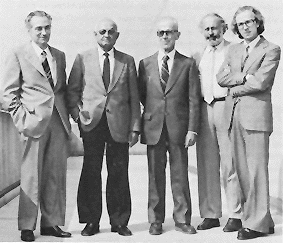History
The Laboratory of Biochemistry was founded in 1956, following a proposal of the late Prof. L. Ružicka - then Chairman of the Laboratory of Organic Chemistry - and thanks to the generous financial support from the chemical industries in Basle and the Rockefeller foundation. In October of the same year, Carl Martius was appointed as the first ETH professor in Biochemistry.
Initially, Biochemistry was viewed as a supplement to the study of Chemistry, constituting a post-graduate course and not a separate curriculum. In 1962, after a revision of the faculty of Chemistry, the Laboratory of Biochemistry became part of the faculty of Natural Sciences and a curriculum in Biochemistry and Microbiology was activated. Biochemistry became quickly popular, such that the Laboratory required additional space and more staff. In 1969 Giorgio Semenza was appointed as a second full professor. In 1973 the Institute moved into the newly built CHN tower building on Universitätstrasse 16, where it occupied the top 4 ½ floors. In the same year, Ernesto Carafoli was appointed, also as a full professor.

Carl Martius retired in 1976 and in 1977 Kaspar H. Winterhalter replaced him. Following the retirement of Giorgio Semenza in 1995, Ari Helenius joined the ETH in 1997. The same year the Laboratory was renamed Institute of Biochemistry.
In 1998, Ernesto Carafoli retired and was replaced in 1999 by Yves Barral and Ulrike Kutay. The retirement of Kaspar H. Winterhalter took place in 2001 and Matthias Peter took over his position in 2002.
The period from 1997 to 2002 brought a major change in faculty and research directions of the Institute. While retaining its strength in biochemistry, research within the Institute shifted its focus towards complex cellular processes, such as cell cycle and cell division, protein sorting, host-virus interactions, and membrane trafficking. The transition was crowned by the move into the renovated building HPM on the Hönggerberg, which took place in February 2002.